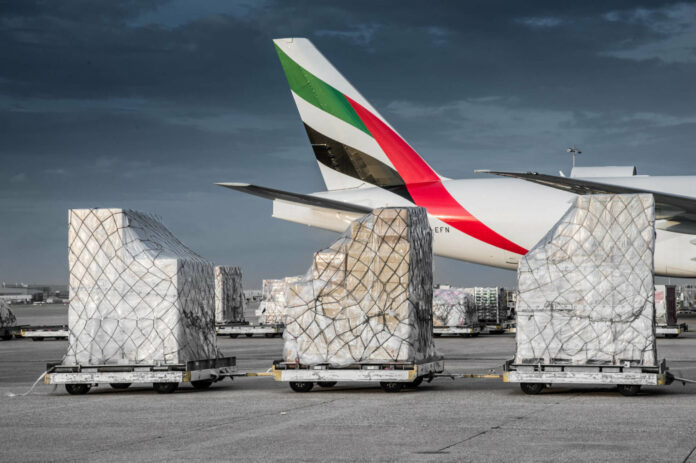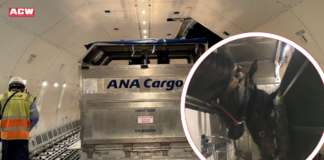

Heathrow Airport holds the illustrious title of the UK’s largest port by value, having handled £153 billion in non-EU imports and exports across a network of over 235 destinations worldwide during 2021, accounting for 3/4 of all British air cargo.
Despite the collapse in passenger traffic, Heathrow maintained strong cargo volumes throughout, supported the movement of vital supplies like PPE and vaccines. Food exports also formed a sizeable section of the airports traffic, with Britain’s biggest food and drink export, salmon, comprising £237 million worth of the goods flown out of the international hub.
Tough few years
“Macroeconomic factors will always have an impact on the industry. If something is having an impact on the industry, it will clearly then filter down to us,” James Golding, Heathrow’s head of cargo, said. “My guess is there’s definitely been a slowdown.”
While Heathrow managed to redirect its focus during the pandemic, it faced more challenges as a passenger-focused airport than its counterparts that had strong existing cargo operations. “In the pandemic, we suffered because we didn’t have a big freighter base to fall back on. Yes, airlines converted to freighter but we don’t have that extensive freighter network because of our very strict slot regime, restrictions on night flights, we’re constrained physically in terms of the space that we’ve got.”
Looking at the data, overall Heathrow’s cargo volumes were 14% down in September compared with September 2019 – the last normal year on record. While that might initially seem disappointing, the month-to-month figures tell a different story, as there was a 6% increase from August to September.
“That’s why our performance compared to some of our European competitor airports, like East Midlands, was relatively poor in terms of time recovery – because of our reliance on bellyhold,” Golding explained, “Obviously in times of passenger growth and cargo then that does work in our favour but I think what we are always trying to do is achieve that balance. And I don’t think previously we got that balance quite right.”
As the UK and the world started to emerge from the impact of the Covid pandemic at the start of 2022, Heathrow had hoped
that there would be faster growth from a cargo perspective
but that was hampered by the geopolitical ripples caused by Russia’s invasion of Ukraine. Amidst all of this though, the airport has started to see the early signs of growth, viewing the next few months as particularly key as the industry heads into the peak Christmas period.
Read more: IAG Cargo opens applications for London-Heathrow based apprenticeship scheme
Changing strategies
Heathrow is in a different position to other regional and international hubs, as it doesn’t own the majority of cargo facilities, meaning that collaboration is crucial with the entire community at the airport and in the wider industry when planning how it will achieve the goals that underpin its broader missions.
Over the past two and a half years, airlines and cargo handlers have been forced to adapt and modify their operations to meet the changing environment. “We need to change our strategy accordingly. Really, we are now about how we can grow our cargo proposition in the safest way, most secure way, most sustainable way,” Golding stated.
“We’re working with our airlines, handlers and, to a certain extent, forwarders to work out the details that sit behind each of those headline statements that we’ve made…There are things that we can do as an industry as a whole to collaborate, share best practice to make sure as an industry we’re working most effectively.”
Golding is cautious to describe other airports as competitors, instead calling them comparator airports, as it’s crucial for the cargo sector to maintain good relationships with one another. After all, to move cargo from point A to point B requires two airports seamlessly operating in lockstep.
“If one airport is leading the way on something but doing that in isolation, that’s not really serving the global cargo market. Frankfurt, Brussels, they all have their own specialisms. They’re all serving a slightly different market. And, actually we need to be talking with those airports and sharing where we can.”
Regional relations
As new hubs emerge across the UK, Heathrow isn’t fazed about losing its status as a global cargo hub and the UK’s largest port. In fact, while there will always be an element of rivalry, Golding welcomed the addition of new airports in the cargo space, recognising how it can benefit the UK as a whole by making the market stronger.
“It’s very similar how we treat our European comparator airports. We need to be collaborating. We need to be as open as we can be. There will always be commercial tension, particularly in a UK context.”
“Are we concerned that we are going to lose routes to other airports? Not really. We’re a primary bellyhold market and the likes of Bournemouth you’re looking at more of a freighter base,” Golding said. “We have a role to play in supporting and facilitating the growth of these businesses to a certain extent, while being conscious of the fact we’ve all got our own commercial agendas as well.”
Read more: Rhenus opens new Heathrow hub
Growth is on the mind
No one could knock Heathrow’s success as an airport but the team isn’t resting on their laurels. The airport is focused on bold plans to invest in infrastructure over the next five years to grow capacity, as well as the sustainability and efficiency of its operations.
“We need to find a way to make sure that we are maximising the advantage of being only 20-25 miles from the centre of London, while being really mindful that we are operating at the finger of our local community,” Golding admitted.
For Heathrow, expansion is twofold. There’s obviously the long-term aspirations to grow the physical footprint of the airport as part of formal expansion plans which have been on pause for the last couple of years. So, Heathrow will be looking to restart those plans in the near future to increase capacity. In the short-term, it is about smaller projects, such as relieving congestion, meeting sustainable strategies and finding ways to be more efficient.
“We very much view our relationship with those property companies [at Heathrow] as a partnership…We work very closely with them to make sure that we are investing to support their delivery as much as their investment supports our own cargo proposition and our own airport…If we’re not working together, we can never make the improvements that we want to make,” Golding added.










